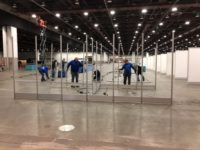COVID-19 and Construction
Walsh Talks About McCormick Convention Center to COVID-19 Care Conversion
First beds were turned over for coronavirus patients April 4, with completion planned April 24








While many convention centers across the country are having partitions erected inside as makeshift facilities to alleviate strain on local hospitals dealing with COVID-19 patients, Chicago's McCormick Place is being prepped to handle only those ill from the coronavirus.
"We are assuming that every patient in McCormick Place is COVID-19 positive, so it is being constructed as a COVID-19 positive alternate care facility," says Col. Aaron Reisinger, commander and district engineer of the U.S. Army Corps of Engineers Chicago Division, which is constructing the conversion in partnership with the Chicago Dept. of Public Health and contractor Walsh Construction.
[For ENR’s latest coverage of the impacts of the COVID-19 pandemic, click here]
Reisinger said Halls A and C of North America's largest convention center will not change much, with cubicles constructed within them to become rooms for patients that have very low acuity of the virus—meaning they do not require oxygen.
Spaces will be three-sided hard cubes with a curtain front, bed, chair and lamp, but there also will be nurse stations and nurse call capability.
Rooms will have typical shower or bathroom areas for privacy. The facility will accommodate those patients that were formerly recovering at home, but who require more monitoring, plus patients released from advanced respiratory care hospitals to recover and convalesce. Having these beds available will provide the city's health and hospital system an alternative place for patients at low risk if they can't yet be discharged.
The convention center is well suited for conversion because "there's an access point, where you have water, electric, sewage and IT" in the floors every 20 to 30 ft area on center, says Reisinger.
Hall C has 500 beds now available and will have another 500 by April 17. Hall A will open 1,250 beds by April 17.
Delivering Oxygen
Hall B requires more work for its 750 beds for moderate acute-care patients, with the Corps targeting April 24 to complete that area. "[These patients] do not require ventilation, they're not in an intensive care unit, and they're not being intubated, but they may require oxygen, and they may require oxygen on a continuous basis," Reisinger says. "They will be more prone to coughing, sneezing, vaporizing the virus. The virus is not an airborne virus, but it is contagious in respiratory droplets from coughs and sneezes."
He adds that "the reason for putting these patients in negative air pressure is to protect the healthcare workers and maintain and isolate the density of the virus within that isolation pod. Each of those patients would be in a contained isolation unit with negative pressure, a HEPA filter system fan that exhausts to a central bank and then exhausts out of the hall itself."
Hall B's own air will be used as the supply air, but a system had to be created to pull the return air out of the the tented isolation pods and create negative pressure in the tents so that any contamination in the rooms can be filtered, and the air drawn out of the building instead of exhausted back into it. HEPA filters will purify anything that's coming out of a patient isolation pod. Each Hall B isolation pod will have in-line air to create steady air pressure and oxygen, medical air, power and light available, says Reisinger. Some mobile ventilators will be available, but if a patient's condition deteriorates, EMS services will be called to transport patients to a local hospital.
"We are bringing in our own medical gases," says Tom Caplis, vice president of health care at contractor Walsh Construction. "We have an oxygen tank farm that's coming here, all the medical gas piping for oxygen and to create the vacuum. A vacuum pump is being placed. There will be a headwall that's placed inside of each one of these tents. These patients [in Hall B] will be the highest acuity, so they will need oxygen" as well as a negative air-pressure environment.
Caplis said Walsh, design consultants Stantec and Environmental Systems Design and the USACE contemplated using bottled oxygen for patients that needed it, but did the calculations as to what a typical COVID-19 patient requires, and realized that bottles wouldn't be able to keep pace. A mobile oxygen tank farm is, instead, being placed on Hall B's loading dock with hard piping bringing it into the space independent of McCormick Place's existing systems.
Stantec and ESD designed an independent HVAC, electrical, mechanical and medical gas system in 48 hours and Walsh's logistics team immediately contacted the medical subcontractors it regular works with that had the fabrication shops necessary to start the process of building and shipping the necessary assemblies for an April 24 turnaround. Walsh's logistics team sent initial specs to subcontractors Mechanical Inc. for HVAC, YMI Mechanical for medical gas; electrical and staging contractors Huen Electric, GES, Vader National Electric and carpentry and millwork contractors Cain Millwork, Starved Rock Millwork and Escarpita Carpentry as they became available.
Big Prefab Effort
"The duct work, that might seem very simplistic, but once we had it designed our contractor, Mechanical Inc., was able to put this through their machines and prefabricate the stuff," Caplis says. "Whatever could fit on a truck came out that day and they did a wonderful job of that. The installation has gone up so quick because of it. On the medical gas side, a lot of that stuff had been done off site. Our scaffolding, our nurses stations come in big pieces. It's a big prefab effort."
Each nurse station has 15 of the patient isolation pods surrounding it. A rack system behind the pods houses the duct work, piping and conduits for medical gas, HVAC and the electrical and mechanical connections necessary to feed air, electric and medical gas to each pod.
"It's not run on the floor," Caplis says. "We had to make a superstructure to accept the mechanical systems that feed these tents."
Freeport, Ill.-based Mechanical Inc. produced the HVAC ducts and other pieces of the system in its Rockford, Ill., fabrication facility. Fabrication began the afternoon of March 29 with a 48-hour turnaround time. Social distancing was observed throughout the fabrication and delivery process.
"Our fabrication equipment is automated enough that it's really mostly machine and not many people," says Brian Helm, president of Mechanical, Inc. "We're easily able to maintain the 6-ft separation in the fab shop. It gets a little harder on the site, but we built ducts in what we call schools, so they're from 10-ft to about 25-ft lengths that we fabricate in the shop. When we deliver it, if you have a person at each end, you're maintaining the 6-ft separation."
Helm said that the company's 40-years of investment in prefabrication facilities and techniques were invaluable in being able to produce the assemblies in the time necessary and under the constraints of the project.
"We used our virtual design and construction department to the extent we needed to," Helm says, "but it's a pretty simple repeatable design. This was right up our alley. We were geared up and ready to go in very little time."
Defining Contract Scope and Cost
The Corps contract with McCormick Place is through the facility's state agency owner, the Metropolitan Pier and Exposition Authority, which hired Walsh as the general contractor for patient cubicles and the in-line air distribution system in Hall B. Reisinger added that the Corps is still working with the authority and Walsh to define contract scope and cost. The Federal Emergency Management Agency has provided $15 million toward the conversion cost.
"It's a pretty significant effort to build the infrastructure, distribute it on a consistent basis, and then be able to exhaust the air out of the tent into a central system and efficiently out of the hall," Reisinger says. "While there's little doubt that we'll have halls A and C ready by April 17, for Hall B, we think we have a production rate of about 250 [acute care cells] per week, starting next week. That's going to take us right up to April 24 and maybe a little bit later. That's what we're targeting," he adds.
Caplis says that the project is on schedule for April 24 and believes that it will be delivered on time for that date. He said that 90% of all the materials needed are on the job site, being prefabricated or already installed.
"I hope, and I pray that this place is never used, but if it is, it's going to be ready and it's going to help the city," Caplis says.








